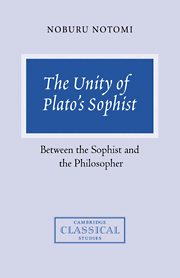Book contents
- Frontmatter
- Dedication
- Contents
- Preface
- Notes and abbreviations
- Division of the Sophist
- 1 How to read the Sophist
- 2 The sophist and the philosopher
- 3 How the sophist appears
- 4 Analysis of the structure of appearance
- 5 Appearance and image
- 6 The sophistic counter-attack on philosophy
- 7 The philosophic defence against sophistry
- 8 The final definition of the sophist
- Bibliography
- Index locorum
- General index
3 - How the sophist appears
Published online by Cambridge University Press: 05 June 2014
- Frontmatter
- Dedication
- Contents
- Preface
- Notes and abbreviations
- Division of the Sophist
- 1 How to read the Sophist
- 2 The sophist and the philosopher
- 3 How the sophist appears
- 4 Analysis of the structure of appearance
- 5 Appearance and image
- 6 The sophistic counter-attack on philosophy
- 7 The philosophic defence against sophistry
- 8 The final definition of the sophist
- Bibliography
- Index locorum
- General index
Summary
Defining the sophist
I have shown in the first two chapters that the basic philosophical problem in the Sophist is how to distinguish the sophist from the philosopher. Now let us begin to discuss how the Sophist investigates the basic problem.
The Eleatic visitor sets out to define the sophist by pointing out an indeterminacy in our understanding of the sophist. The dialogue starts the inquiry with an agreement that people share a common name:
[Passage 2: 218c1–5]
The Eleatic visitor: At present, what you and I possess in common concerning this (sc. sophist) is the name (onoma) alone, but each of us may perhaps understand privately the thing (or the activity, ergon)to which we give the name. Yet it is always necessary concerning everything to come to an agreement on the thing itself by means of definitions (or statements, dia logōn), rather than about names alone without definition.
In order to understand the meaning and the procedure of defining the sophist, we should look, to begin with, at the three methods employed in the dialogue: definition, use of models, and division.
The aim of definition is stated in Passage 2: that a definition (logos) should fix our understanding of an object to which a certain name (onoma) refers. Let us consider what role the three elements, that is, name (or word), object, and definition, play when we inquire into a definition of something.
- Type
- Chapter
- Information
- The Unity of Plato's SophistBetween the Sophist and the Philosopher, pp. 74 - 94Publisher: Cambridge University PressPrint publication year: 1999



